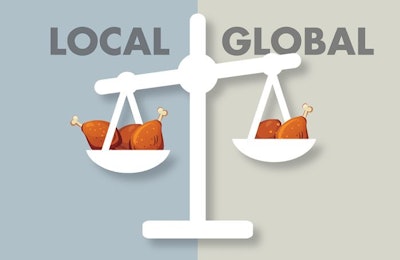
Global trade in poultry meat could be heading toward a series of significant disruptions as 2018 progresses, prompting Rabobank to warn in its "Poultry Quarterly Q2 2018" that the sector could face “its biggest shakeup in decades this year.”
Among factors cited by the bank are the repercussions from Brazil’s Weak Flesh investigations, including recent restrictions on EU trade; a pending ban on meat from stunned birds in Saudi Arabia; North American Free Trade Agreement (NAFTA) renegotiations; and Chinese dumping investigations of Brazilian product. Avian influenza will also have an ongoing negative impact.
Brazil will be the most affected
The possibilities of disruption to global trade streams and prices are strong this year and, of all countries, Brazil may be the most affected.
The implementation of a ban on stunning in Saudi Arabia, Brazil’s largest export market, could hit the Brazilian industry hard, particularly given that there are limited alternatives for its whole bird exports.
The country is also coping with restrictions in its leading export market for breast meat -- the EU -- due to concerns over Salmonella.
Countries including Ukraine, Russia and Poland stand to gain if Brazil loses market share, but they will not be able to fully replace Brazil’s position in these markets.
Additionally, Brazil is losing the advantage it gained when competitors were hit by avian influenza. The U.S. in particular has been regaining markets with its outbreaks now behind it, and the loss of confidence in Brazilian product.
Global prices
EU trade restrictions are impacting breast meat prices, the Saudi standard is challenging the whole bird market, and the China-Brazil dispute and NAFTA renegotiations could potentially affect the dark meat market.
If NAFTA renegotiations result in trade restrictions, it may be difficult for the U.S. to find alternative markets for its dark meat, putting downward pressure on dark meat prices. The country exports 3 million tons of poultry meat each year, with Mexico absorbing 20 percent and Canada a further 5 percent. Any changes to U.S. poultry exports to these markets could affect the industry outlook and indirectly affect global market conditions.
Rising prices may be ahead, however, for local producers and exporters who sell in the EU and Saudi Arabia as imports are restricted, while whole bird and breast meat prices on global markets will decline significantly.
Avian influenza impact to continue
Pressure from avian influenza remains significant, but the number of cases is lower than in the 2016-17 Northern Hemisphere winter season.
Although China, Japan, the EU, India, Russia and the Middle East have recorded outbreaks, the number of cases so far this year has been lower and, should this continue, the result will be fewer disruptions to global trade in broiler meat, as well as to trade in breeding stock.
China has seen a remarkable recovery from avian influenza, with one of the most profitable winter seasons in years for the industry, due to avian influenza vaccination.
Local industries will perform well
South Africa and Mexico in particular are performing well, as are Indonesia, India, Japan and the U.S. The EU is also performing relatively well, notes Rabobank, and breast meat prices are likely to rise due to restrictions on Brazilian product.
Russia and Thailand, however, are suffering from oversupply after expansion, and will be looking to capture some of Brazil’s lost market share.
The EU industry will benefit from rising breast meat prices, and prices in Saudi Arabia are expected to rise sharply. The country has a self-sufficiency rate of only 45 percent and there will be no alternative supplier who can replace Brazil and the EU once new halal standards are implemented.
The weakest-performing countries this year are expected to be Brazil, Thailand and Russia. Thailand and Russia have over-expanded production, resulting in oversupply in their home markets. While both countries are reporting rising exports, this will not be enough to compensate for weak local demand.
Feed price concerns
Beyond global trade volatility, however, increasing feed prices are a significant concern. Droughts in the Southern Hemisphere have resulted in rising prices. Most of the negative impact should be offset by high global stock levels, but any worsening of the outlook could affect future feed prices.

While in some markets, and for some product types, prices can be expected to increase, for others excess supply could lead to prices falling. | Watt Global Media.
New poultry market data available to download:
















